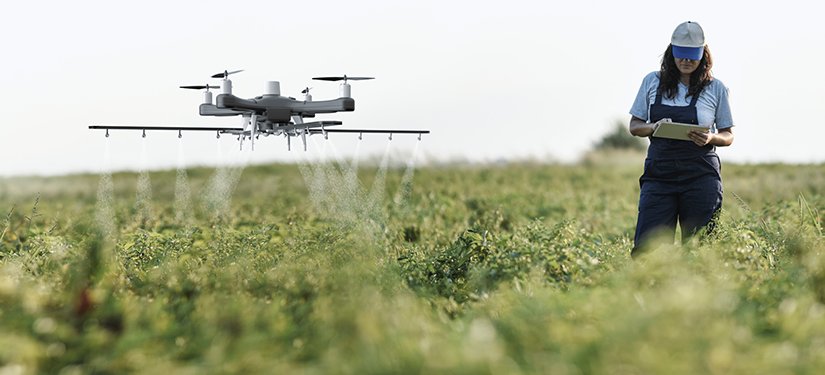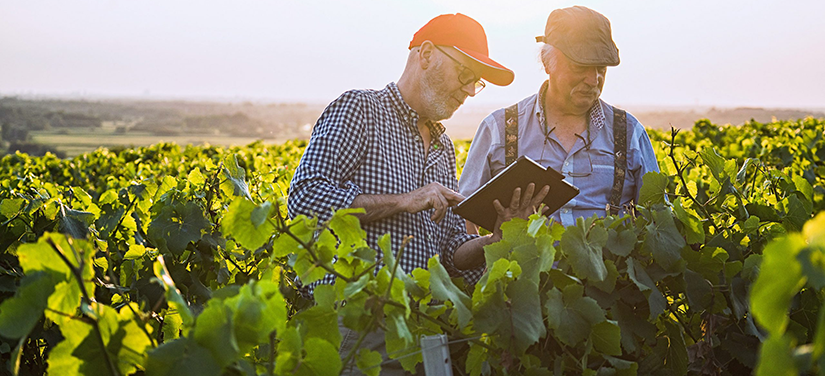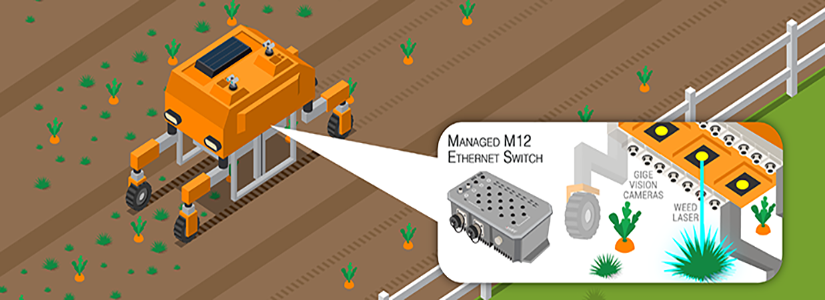
From the factory to the field: AgTech comes of age
By Henry Martel, Field Application Engineer, Antaira Technologies
Features agricultural technology AgTech Antaira Ethernet switches IIoT Industrial switches
With the world’s population on track to reach 9.7 billion people by 2050, farmers will need to grow twice the amount of food they do today to avoid scarcity issues and social disruption.
Agriculture technology or “AgTech” will play a pivotal role in alleviating the building pressure on farmers to produce more by providing improved control and real-time data insights of farming operations for more efficient management of crops, resources, and livestock.
A product of the Industrial Internet of Things (IIoT), AgTech refers to the use of connected technology in agriculture, horticulture, and aquaculture. It empowers farmers to operate “smarter,” leading to higher revenues, lower costs, and increased margins. Like the IIoT, AgTech seeks to do more with less in leveraging a cross-section of networked devices to uncover ways to boost productivity without burdening already overtaxed natural resources.
AgTech tools include, but aren’t limited to:
- Sensors collecting data on temperature, crop growth, precipitation, humidity, wind, animal health, and soil quality;
- Automation systems for irrigation, pest control, fertilization and other critical production cycle processes;
- Drones to distribute pesticides, determine soil health, mapmaking, aerial surveillance, and the monitoring of animal herds. Since most agricultural concerns cover huge tracts of land, the current generation of drone technology is a perfect fit;
- Geo-positioning to accurately create farm maps, and to ensure that soil samples and crop conditions are collected for analysis in the same areas, year after year;
- Robots to tackle labor-intensive, repetitive, and physically demanding tasks i.e., harvesting crops, hauling heavy loads, milking cows, pruning vines, and destroying weeds;
- IP video surveillance systems to monitor for intruders and to act as a deterrent against acts of tampering, theft and vandalism to high-value crops;
- Networked monitoring devices that measure levels of silos and warehouses. These devices can also trigger automated reordering, reducing inventory costs for farmers;
- “Supervised autonomy” (unmanned vehicles) where the farmer is not in a tractor, harvester, or seeding machine but remotely supervising it with a pendant. GPS maintains path accuracy while sensors help the vehicles avoid obstacles. Currently, this is the largest segment of agricultural automation;
- Artificial intelligence for analyzing weather forecasts, yield projections, and the probabilities of crop diseases. For example, an AI program can run tests on various crop strategies without the farmer actually risking the loss of major tracts of fertile land for a growing season.
These AgTech tools and many more are in use today, allowing farms both large and small to be more profitable, efficient, safer and more environmentally responsible.
AgTech Market Expected to Boom in Next Decade
Over the past century, agricultural advances were largely mechanical, coming in the form of more powerful machinery, or through chemistry concocting more potent seeds, nutrients, pesticides, and fertilizers.
Now, agriculture is in the early stages of yet another upheaval — AgTech — once poised to ratchet up yields, enhance resource efficiency, and establish resilience across crop cultivation and herd management. While it is true that AgTech currently faces hurdles before it reaches wide-spread adoption, there is no denying its potential growth. Total investments in the sector for 2021 reached $10.5 billion. By 2025, the market value of AgTech is expected to surpass the $22.5 billion mark. According to McKinsey, if AgTech is implemented successfully, the industry could tack on $500 billion in additional value to the global gross domestic product by 2030.
Two major hurdles facing AgTech are operational traditions and an ambivalence to investing into the unfamiliar. Both can be attributed, in part, to an aging farm population. For example, the average age for a U.S. farmer today stands at just under 60 years old. Set in their ways, this age group has been resistant to change and to investing in new technology.
With that said, there is an up-and-coming generation of younger farmers whose mindset is more open to the application of AgTech to traditional farming practices. While they currently make up less than 15% of U.S. farmers, those under the age of 35 better understand the vast potential of AgTech, and how to analyze the data it generates.
These are farmers after all, that came of age during an era of disruptive technologies ranging from smartphones and Wi-Fi to Google and electric vehicles. AgTech is not an alien concept to them — they welcome it. In fact, one agriculture research firm BitWise Industries expects 75% of AgTech products to be purchased by farmers under the age of 35 over the next five years.
AgTech and Employee Shortages
According to AgAmerica, hired farmworkers provide 35% of the total hours worked on a farming operation, second only to the principal operator. They perform essential daily tasks needed to keep a successful farm running, such as caring for livestock, working in the fields, and maintaining farm machinery.
The problem today is that farmers are struggling in finding these workers, with small to medium-size farms hit hardest by the effects of farm labor shortage. Increases in education and job opportunities, immigration policies, declining interest in agriculture as a career, and falling birthrates are among the myriad issues that have contributed to a 52% drop in available farmworkers.
As a result, farmers are turning to alternative options to compensate for the current labor shortage predicament, and AgTech is at the top of their list. The American Farm Bureau Federation reported 56% of U.S. farms have begun using AgTech with more than half stating labour shortages as the reason. These farmers are realizing that the investment in AgTech is well worth the initial cost so they can reduce their long-term reliance on a shrinking pool of seasonal labourers.
Robots Ease Labour Shortage
The purpose of robotics is to ease physical burdens and allow human beings to use their intellectual capabilities. Robots in agriculture can achieve exactly this, thereby allowing farmers to strategize better with their land, labour, and resources rather than performing time-consuming, dangerous field work. Importantly, the robots also limit requirements for additional farm workers.
Harvesting is a key area for robotics. Combining machine vision with advanced algorithms, robotic harvesters work around the clock without vacation or time off, picking more fruit per hour than a seasonal picker will pick in an entire day. One popular robotic harvester is able to collect 10,000 apples an hour using a three-fingered grip that grabs and twists fruit from a branch without damage. Grasping hands in harvesting robots are easily modified to pick different fruit types. This makes the robot available for various harvest seasons, adding value to its investment. Image processing algorithms detect if the fruits are damaged, diseased, or unripe.
AgTech’s Backbone: Connectivity
As we mentioned earlier, AgTech is an offshoot of the IIoT. Like the IIoT, the “things” that comprise AgTech — drones, probes, sensors, cameras, electronic tags, robotics, autonomous vehicles, artificial intelligence — are connected to a network where they can interact with each other and the Internet. Unlike in a factory setting, however, the “things” in this version of the IIoT also include tractors, weather stations, sprinklers, remotely located sheds, crops, sheep, and cattle.
Data collected from these things are transferred through a gateway via the network to data management applications where it is viewed, stored, and analyzed for more informed decision-making. For example, devices on the network can also send alarms to the farmer to perform maintenance on a tractor before it breaks down or be used to automate other “things” on the network like a sprinkler system that activates if a moisture sensor indicates the soil is too dry.
Being remotely located, AgTech networks rely largely on wireless connectivity. Wired connectivity is rarely available in rural areas, leading the network technician to fall back on one of five types of wireless providers: Mobile carriers, IoT-specific carriers (Sigfox, LoRaWAN), Point-to-Multipoint fixed wireless carriers or “WISPs”, Point-to-Point fixed providers, and user-installed equipment that links back to wired-based carrier service.
No matter which wireless service is selected, at the centre of AgTech’s hyper-converged infrastructure are managed Ethernet switches that connect devices together. Industrial switches filter and forward data to and from devices, while also providing administrators with the ability to configure, manage and monitor devices on the network. Quality of Service (QoS) lets administrators prioritize trafficking and bandwidth to ensure that the most important data reaches its destination first, for example, real-time video surveillance of an intruder versus monitoring levels of a watering trough.
A high-quality industrial Ethernet switch delivers ultra-low latency, improved network stability, and fast responsiveness that builds trust in farmers to confidently run complex new applications, such as operating autonomous machinery and drones in outdoor environments. Bumpy terrain in a plowed field can cause a rough ride for any switch, but it’s no problem for Antaira’s industrial 10G Ethernet switches. Many models feature M12 Ethernet connectors that prevent cables from disconnecting from vibration plus will stop water ingress during washdowns at the end of the day.
Conclusion
Whenever we envision a traditional family farm, the images are typically of fields of golden wheat, herds of grazing cattle, and farm hands busy harvesting crops, feeding animals, and maintaining machinery the farm depends on. Under closer inspection, though, we realize that the agricultural sector is changing right before our eyes. That change is accelerating to address the critical needs of a growing world population for food with AgTech playing a starring role.
Print this page

